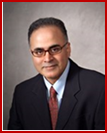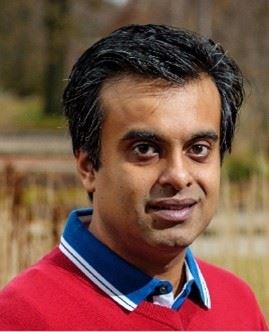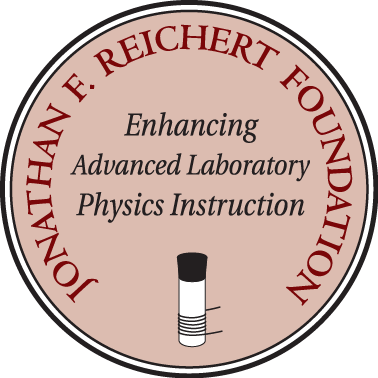- Home
- What We Do
- Laboratory Immersions
- Immersions 2024
- Imm2024RoseHulman_Interferometry&MO
Rose-Hulman Institute of Technology, Terre Haute IN
Interferometry and Magneto Optics
July 12, 2024 to July 14, 2024
Number of setups
available: 2
Maximum
number of participants: 4
------------------------------------------------------------------------------------------------------------------------------------------
Overview:
The experiment will allow participants to learn about the fundamentals of interferometry and how interferometers can be used to probe the magneto optic response of various samples. The participants will also learn about the theoretical fundamentals of Faraday Rotation and the related measurement. We anticipate that this proposed activity will serve as a useful example of optics and magnetism for advanced undergraduate curriculum.
Our proposed experiment can be subdivided into two smaller stages. In the first stage the participants will build a Michelson Interferometer using typical undergraduate level optics. They will also spend time learning the differences between Michelson and Twyman-Green interferometers. In the second stage, they will use the interferometer they have built and characterized to study magneto optic response of a dielectric. During this stage of the Immersion, they will first learn about using the interferometer to investigate the optical thickness of the glass sample. This will be followed by subjecting the sample to a magnetic field. With the information gathered from the previous experiment, the participants will be able to calculate the Verdet constant of the sample.
All along, the participants will have a chance to learn about the nature of noise that can impact these measurements, and how this noise can be quantified and minimized.
Price List
Our proposed experiment can be viewed as having a magnetics component and an optics component.
Optics and Optomechanics
1. Power Beam Splitter: One (1) 50:50 power beam splitter splits the beam from the laser source to propagate between the reference and sample arms. The beam splitter is also responsible combining the returning beams from the two arms before the detection process. A typical beam splitter costs between 200 to 300 dollars. A sample beam splitter cube that could be usedThorlabs BS013 50:50 Beam splitter cube
2. 1-inch Optical Mirrors: Two (2) optical mirrors are required to construct a Michelson interferometer. Two Mirrors should cost between $100-150. Protected Silver Mirrors
3. Spherical Lens: One (1) lens would be needed to focus light on the photodetector to maximize photon collection. A 1-inch diameter lens of focal length 50mm would suffice. It costs roughly $50. 1-inch spherical singlet lens
4. 1-inch holders: Three (3) 1-inch holders will be required to mount the lens and the mirrors. These should cost a total of approximately $50. Thorlabs 1-inch mounts
5. Optical Translation Stage: One (1) manual optical translation stage will be required to fine tune the reference arm mirror of the interferometer to ‘balance’ the interferometer optically. A manually-operated translation stage costs in the range of $300-400.
Manually-operated translation stage
6. Optical Posts and Post Holders: We would required five (5) 4-inch optical posts and corresponding post holders. The 6 pedestal posts would cost in the range of $150-200 total. The optical posts should cost about $50. Pedestal Posts and Optical Posts
7. Optical Clamping Forks: We would need one pack of five (5) clamping forks to hold the pedestal posts. These should cost about $50-100 (for a pack of 5). Clamping Forks
8. Beam Splitter Cube Holder: One (1) holder to hold the beam splitter cube is required. It costs $100-200. Prism Mount
Magnetics:
1. Helmholtz coils: Many refurbished coils are available on sites like e-bay. We use coils from 3B scientific and Pasco. Their prices are in the range of $900 and $400, respectively. A good machinist should also be able to wind two coils and 3D print a base to make a Helmholtz coil setup inhouse. 3B Scientifc HH Coil Pasco HH coil2. Audio Amplifier: Various amplifiers are available in the $300-$800 (and above) range that are well-suited for the experiment.
3. Ammeter and Function Generator: These are instruments that are widely used in Physics laboratories.
4. Light source: We use a diode laser and a Helium-Neon laser. These are also typically available in most undergraduate physics labs. Thorlabs is a good source. He-Ne lasers range from $1,000 to $3,000. The diode lasers can also be obtained from Thorlabs for a variety of wavelengths. He-Ne Lasers (Thorlabs) Laser Diode Module (Thorlabs)
5. A digital oscilloscope is needed. Ours typically have a bandwidth of 200 MHz. Prices range from $400 to $2000, depending on the features needed. Digital Scope
6. Biased photodetectors: We use Thorlabs detectors. They can range in price from $200 to $500. Thorlabs Detectors
Host and Mentor:
 Maarij Syed received his BS from University of Oklahoma (1991) and his PhD from University of Notre Dame (1998). For his PhD work he joined the group of Prof. Dobrowolska-Furdyna working on magneto-optics of II-VI and II-V semiconductor heterostructures. His doctoral work was on magneto-optics of small offset superlattice structures based on II-VI semiconductors. In the fall of 1998, he joined the Department of Physics and Optical Engineering at the Rose-Hulman Institute of Technology as a Visiting Professor and then in Fall of 1999 as an Assistant Professor. His area of research has included investigations of novel materials for SPR applications and magneto-optics of superparamagnetic nanoparticles. Current nanoparticle research is largely focused on size determination of nanoparticles and investigation of their relaxation dynamics. He also has continued interest in pedagogical issues related to electromagnetism. Other research interests include investigation of silica nano-films fabricated through spin coating techniques and their humidity response. This research is carried out in collaboration with the Dept. of Chemical Engineering and is largely based on using ellipsometry to characterize the silica films in various humidity environments.
Maarij Syed received his BS from University of Oklahoma (1991) and his PhD from University of Notre Dame (1998). For his PhD work he joined the group of Prof. Dobrowolska-Furdyna working on magneto-optics of II-VI and II-V semiconductor heterostructures. His doctoral work was on magneto-optics of small offset superlattice structures based on II-VI semiconductors. In the fall of 1998, he joined the Department of Physics and Optical Engineering at the Rose-Hulman Institute of Technology as a Visiting Professor and then in Fall of 1999 as an Assistant Professor. His area of research has included investigations of novel materials for SPR applications and magneto-optics of superparamagnetic nanoparticles. Current nanoparticle research is largely focused on size determination of nanoparticles and investigation of their relaxation dynamics. He also has continued interest in pedagogical issues related to electromagnetism. Other research interests include investigation of silica nano-films fabricated through spin coating techniques and their humidity response. This research is carried out in collaboration with the Dept. of Chemical Engineering and is largely based on using ellipsometry to characterize the silica films in various humidity environments.
 Syed Azer Reza received a BS in Electrical Engineering from the GIK Institute of Engineering Sciences and Technology, Pakistan (2003) and an MS is Electrical Engineering from the Darmstadt University of Applied Sciences, Germany (2005). He then joined the College of Optics and Photonics (CREOL) at the University of Central Florida where he earned his MS (2007) and a PhD (2010) degrees in Optics. His PhD dissertation focused on developing novel sensing techniques using MEMS and microfluidic technologies.
Syed Azer Reza received a BS in Electrical Engineering from the GIK Institute of Engineering Sciences and Technology, Pakistan (2003) and an MS is Electrical Engineering from the Darmstadt University of Applied Sciences, Germany (2005). He then joined the College of Optics and Photonics (CREOL) at the University of Central Florida where he earned his MS (2007) and a PhD (2010) degrees in Optics. His PhD dissertation focused on developing novel sensing techniques using MEMS and microfluidic technologies.
He has since been involved with several higher education institutions in various teaching and research capacities. For two years, he worked as a post-doctoral associate (2010 - 2012) at the Laser Interferometer Space Antenna (LISA) labs at the University of Florida under Prof. Guido Mueller who is one of the leading experts in ground-based and extra-terrestrial gravitational wave detectors. Dr. Reza was a part of the computational optics group at the University of Wisconsin-Madison for almost three years where he was involved with developing novel techniques in time-of-flight imaging, imaging around corners, and fluorescence lifetime imaging.
Dr. Reza has also been an educator serving as an Assistant Professor at the Lahore University of Management Sciences (2012-2017) and the Rose-Hulman Institute of Technology (2019-present) where he has taught and supervised undergraduate, MS, and PhD research. He current areas of interests include computational interferometry, beam shaping, and investigation of magneto-optic response of super-paramagnetic nanoparticles and transparent oxide thin films.
Please note that the Jonathan F. Reichert Foundation has established a grant program
to help purchase apparatus used in Laboratory Immersions. Limitations
and exclusions apply, but generally speaking the Foundation may support
up to 50% of the cost of the required equipment.




